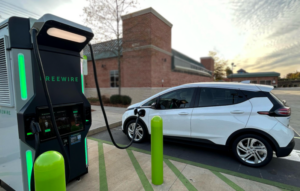Whelp, that was fast. No sooner does the Ford Motor Company put Kentucky on the clean tech map for EV battery manufacturing, when along comes the leading hydropower company Rye Development with a proposal to make Kentucky an epicenter of the long duration energy storage trend. Long duration storage is the final nail in the coffin for the domestic coal industry, which kind of puts Kentucky policy makers in the hot seat considering that the economy of The Bluegrass State still leans on coal.
US Energy Hearts Long Duration Energy Storage
For those of you new to the topic, lithium-ion battery technology is the gold standard for short term energy storage of a few hours or so, but the US Department of Energy is aiming for duration of at least 10 hours to support the sparkling green grid of the future.
Actually, 10 hours is the low bar. Ideally, the Energy Department is looking for days, weeks, and even seasons of energy storage. Right now, pumped hydro storage is the only medium that can fit that bill in the US and elsewhere.
The basic idea behind a pumped hydro “water battery” is to use renewable energy to pump water uphill to a reservoir during periods of low electricity demand. During periods of high demand, the water is released downhill to run turbines for generating electricity, so gravity does all the heavy lifting.
Pumped hydro systems come in two basic types. Open systems send the stored water into the local waterway, where it continues upon its way after passing through the turbines. Closed systems re-use the same water over and over again.
Huge Long Duration Energy Storage Project For Kentucky
The new Rye Development long duration storage project is a closed loop system that would go to Bell County, which is located by the southeast corner of Kentucky.
According to Rye, the project is already in development under the name Lewis Ridge Closed Loop Pumped Hydropower Storage project, and papers have been filed with the Federal Energy Regulatory Commission for a permit that would grant it a license to operate for 50 years. Here, let’s have them explain it:
“The Lewis Ridge pumped storage project is located adjacent to the Cumberland River near the communities of Blackmont, Tejay, Balkan and Callaway, Kentucky. The project site sits on a former coal strip mine in an active coal mining area. As coal is phased out of the grid across the nation, coal communities face uncertain employment and economic futures. Projects like Lewis Ridge create new jobs and economic activity in energy communities.”
If all goes according to plan, the end result will be almost $1 billion in investor dollars flowing into the county, along with 3 to 5 years worth of “family wage” construction jobs for about 2,000 workers.
Rye doesn’t explain what they mean by family wage, but that is generally understood to be enough money for the wage earner to support dependents, who can presumably stay home and take care of each other instead of relying on day care.
The company transparently divulges that there will only be “several dozen direct and indirect family-wage jobs” on a permanent basis. That doesn’t sound like much. However, for those of you keeping score at home “several dozen” will meet, if not beat, the job creation once promised by the notorious Keystone XL fossil energy project.
Considering the ability of renewable energy resources to spark new economic activity, those several dozen jobs could lead to additional investor interest in the area.
Where Are All The Clean Kilowatts Going To Come From?
Left unanswered in Rye’s announcement is the question of whether or not renewable energy will be used to pump water for the energy storage project.
Rye suggests that wind and solar resources are the perfect match for long duration energy storage, which they are:
“Long duration electricity storage, particularly pumped storage hydro, will help solve the challenge of how to take the wind and solar energy which is generated when the wind blows and the sun shines and transform that into energy that can keep the lights on around the clock.”
The company also implies that wind and solar will play a leading role in this particular project:
“Pumped storage offers a flexible solution to the changing grid, including the ability to store intermittent solar and wind resources moving forward. When constructed, the Lewis Ridge project will have the ability to generate over 200 MW for 8 hours.”
However, it’s a mystery where all that wind and solar energy will come from in Kentucky.
One problem facing the state is that wind resources there, and elsewhere in the southeast, are less than optimal. That could eventually be resolved with next-generation wind turbine technology and taller wind turbines, but that is somewhere off in the future.
That partly explains Kentucky’s lowly position on the wind energy scale among the US states. It currently weighs in at #50 with a mere 26 megawatts of installed capacity to its credit.
Kentucky doesn’t fare much better in the solar energy department either. It has nailed down the #47 slot with 68.3 megawatts in capacity, while neighboring Tennessee has 356.2 megawatts.
Here They Are!
All that is about to change, bigly. The firm Savion Energy is planning a 200 megawatt solar farm at a former coal site in Martin County, and that could just be the beginning.
Last month, Savion was acquired by Royal Dutch Shell. The deep-pocketed oil and gas stakeholder has already been sniffing around for solar development opportunities in underserved states like Kentucky.
Shell got a running start back in 2018 when it acquired the Tennessee firm Silicon Ranch. Just last spring, Silicon Ranch announced a massive solar deal in Logan County, Kentucky. Facilitated by the Tennessee Valley Authority, the project assigns 145 megawatts to Facebook’s new data center and 28 megawatts to General Motors’ new Corvette factory. The project also includes a 120-megawatt battery energy storage system.
Long Live Long Duration Energy Storage
So much for Kentucky being asleep at the renewable energy wheel. The idea of repurposing old coal sites for renewable energy and energy storage is not a new one, but it sure did take a while to catch on. Part of the problem is that many coal sites are not located near population centers where people could put all that clean energy to use.
On the other hand, some coal sites have grid connections, road access, and other features that can attract clean tech investors like Rye.
Rye notes that the existing coal site is “unique and features beneficial topography and proximity to transmission infrastructure.”
“These features allow Lewis Ridge to bring a significant amount of economic development benefit to adjacent communities while also preserving ratepayer reliability and affordability,” Rye adds.
If you caught that thing about the Tennessee Valley Authority, that could also come into play. TVA is on a renewable energy tear of late, and 10% of its service territory is in Kentucky.
Except for hydropower, TVA’s clean tech efforts in Kentucky have been minuscule to date, but that Logan County project puts them front and center in the state’s clean energy transition.
Follow me on Twitter @TinaMCasey.
Image (screenshot): Closed loop pumped hydro energy storage project in Oregon courtesy of Rye Development.
Appreciate CleanTechnica’s originality? Consider becoming a CleanTechnica Member, Supporter, Technician, or Ambassador — or a patron on Patreon.

- 000
- access
- active
- Additional
- Advertise
- Aiming
- All
- among
- announced
- Announcement
- AREA
- around
- authority
- battery
- Bell
- Bill
- Billion
- Capacity
- care
- Catch
- caught
- challenge
- change
- clean energy
- cleantech
- Cleantech Talk
- Clock
- closed
- Coal
- commission
- Communities
- company
- Connections
- construction
- continues
- county
- credit
- data
- Data Center
- day
- deal
- Demand
- Department of Energy
- Development
- DID
- dollars
- dozen
- Dutch
- Economic
- economy
- electricity
- employment
- energy
- EV
- Face
- facing
- factory
- family
- FAST
- Features
- Federal
- Firm
- fit
- Ford
- Forward
- future
- Futures
- GAS
- General
- Gold
- grant
- Green
- Grid
- Guest
- here
- High
- Home
- How
- How To
- HTTPS
- idea
- Including
- industry
- Infrastructure
- interest
- investor
- Investors
- IT
- Job
- Jobs
- keeping
- Kentucky
- lead
- leading
- License
- local
- Long
- manufacturing
- map
- Match
- medium
- Mining
- money
- Near
- Offers
- Oil
- Oil and Gas
- open
- Oregon
- Other
- Patreon
- People
- planning
- Play
- podcast
- policy
- population
- project
- projects
- proposal
- pump
- regulatory
- renewable energy
- Resources
- Run
- running
- Scale
- Shell
- Short
- Sites
- So
- solar
- solar energy
- SOLVE
- spring
- start
- State
- States
- stay
- storage
- store
- Strip
- support
- system
- Systems
- tech
- Technology
- The Future
- turbine
- us
- wage
- Water
- weighs
- Wheel
- WHO
- wind
- wind energy
- wind turbine
- workers
- worth
- years









